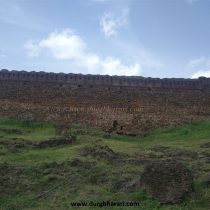AJANTHA
TYPE : NAGARKOT
DISTRICT : AURANGABAD
GRADE : EASY
Ajantha is famous for its Ajanta Caves. The influence of these caves on the tourists is so much that other historical monuments of this area are completely neglected. One of these monuments is the Nagarkot Ajantha of Ajantha village itself. Ajantha is a central point connecting the important cities of Aurangabad – Jalgaon and Aurangabad – Buldhana. Fortifications were built around this entire city which flourished during the medieval period. Even today, these fortifications have survived to a great extent. 36 bastions, four main gates, 5 to 8 sub-doors, ramparts and other structures are still largely preserved in the fortifications of this fort spread over approximately 128 acres. This fort was built during the Mughal period and the influence of Mughal architectural style can be felt on this Fort. This flourishing city today retains its identity only because of the Ajantha Fort.
...
About 95 km from Aurangabad. While coming from Jalgaon, Soygaon is about 15 km from the fork. Above is Ajantha Ghat and Ajantha village on the highway just after crossing the valley. Ajantha Fort generally consists of two parts. One is the ground fort (Bhuikot) surrounding the village of Ajantha and the other is the fortress for special people, i.e. for the royal family and soldiers, inside this ground fort. The triangular-shaped Ajantha Fort is situated on the banks of the Waghur River and the Fort was flanked by a deep bed of the Waghur River and a moat on the land side. Today, except for the southern side of Fort, the trench on the other side is completely buried. On the way from Aurangabad, about one km from Ajantha village. Lately, the north facing gate of Ajantha Bhuikot fort and part of the fortifications can be seen on the left. There is a deep moat outside the ramparts and on the left side, the river Waghur falls into a deep valley. There is an ancient stone bridge on this path from where one can enter the Fort. Before going to Fort, descend on the left side and see the ancient dam built on the river Waghur. From here there is a beautiful view of the Fort door, fortifications and stone bridge. All the four door arches of Ajantha ground fort and the inner wooden doors and Dindi doors are still there. The door of the Fort is 20-25 feet high and two pillars are seen on both sides of the door. Inside the door there are guard houses and there are barns built in the ramparts. This rampart can be climbed through the door. From here it can be seen that the fortifications has been built around the entire village. The fortifications has collapsed in many places and it is not possible to explore it from the ramparts. As Ajantha village is situated in the fort, most of the area is occupied by habitation. From this gate of the Fort, the entire Fort can be traveled by car. After entering through this path and passing some distance, on the left hand side, another gate of the Fort can be seen. In many places inside the fort, one can see the inner fortifications built around the inner palaces. Since this area is private, there is no internal access. There are stairs and arches to climb up in many places in the ramparts and other fortifications. If you proceed from here on the left side, there is a porch. A straight path from this porch leads to the bastion on the ridge outside the village. There is a big bastion on this ridge and another bastion at the opposite end and some remains of fortifications are visible. Here some of the old buildings of the fort can be seen. If you go left from the porch, you can see the inner fortifications of the fortress and an old building, while on the far right, you can see the two main gates of Ajantha fortress. On this road, there is a 350 years old mosque on the left and an old structure on the right. If you go straight ahead through this path, you will enter Ajantha Fortress and you can go out of it through the opposite path. (As Ajantha fortress is a separate monument, detailed information about it is given on the page Ajantha gadhi. Outside this door of the Fortress there is a pushkarni and many Hindu religious ruins can be seen here. The history of this fort is unknown and locals say that it was built during Aurangzeb's time, but Pushkarni outside the Ajantha Fort and the nearby Ajantha Caves suggest that it was inhabited before that. Ajantha ground fort can be seen easily by sitting in a car. This fort is not to be missed when visiting Ajanta Caves. This fort, filled with medieval ruins, should be visited at least once before it falls into disrepair. You need at least two hours to see the entire Ajanta Fort and the Ajanta Fortress.
© Suresh Nimbalkar













